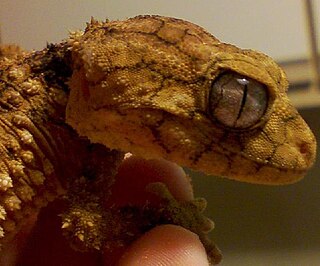
Myrtaceae or the myrtle family is a family of dicotyledonous plants placed within the order Myrtales. Myrtle, pohutukawa, bay rum tree, clove, guava, acca (feijoa), allspice, and eucalyptus are some notable members of this group. All species are woody, contain essential oils, and have flower parts in multiples of four or five. The leaves are evergreen, alternate to mostly opposite, simple, and usually entire. The flowers have a base number of five petals, though in several genera the petals are minute or absent. The stamens are usually very conspicuous, brightly coloured and numerous.

The knob-tailed geckos or knob-tails, are a group of species of geckos, all found in the genus Nephrurus.

Phyllurus is a small genus of Australian leaf-tailed geckos. Rarely seen outside their native habitat, they are notable for their highly effective camouflage which is in part aided by the spiny tubercles that cover every body part.

Underwoodisaurus is a small genus of Australian geckos, commonly known with the species Uvidicolus sphyrurus as thick-tailed geckos. The species Underwoodisaurus milii is often called the thick-tailed gecko.

Underwoodisaurus milii is a species of gecko, a lizard in the family Carphodactylidae. The species is commonly known as the thick-tailed or barking gecko, referring to its distinctive plump tail and sharp, barking defensive call. The genus is also often called thick-tailed geckos as a group, along with the species Uvidicolus sphyrurus.

Baeckea is a genus of flowering plants in the myrtle family, Myrtaceae. There are about 75 species, of which 70 are endemic to Australia; the others are distributed in New Caledonia and Southeast Asia.

The September 11 attacks, often referred to as 9/11, were a series of four coordinated terrorist attacks by the Wahhabi terrorist group Al-Qaeda against the United States on the morning of Tuesday, September 11, 2001. The attacks resulted in 2,977 fatalities, over 25,000 injuries, and substantial long-term health consequences, in addition to at least $10 billion in infrastructure and property damage. It is the deadliest terrorist attack in human history and the single deadliest incident for firefighters and law enforcement officers in the history of the United States, with 343 and 72 killed, respectively.

Astartea is a genus of flowering plants in the myrtle family, Myrtaceae. The genus is endemic to southwestern Western Australia. The genus name was inspired by Astarte, the Greek name for the goddess Ishtar.

Buprestis is a genus of beetles in the family Buprestidae, the jewel beetles. As of 2011 there were 78 described species distributed across most of the world's biogeographic realms except parts of Africa and Antarctica.
Seorsus is a genus of flowering plants in the family Myrtaceae. The occurrence of the four species in Australia and Borneo is widely spaced, and is thought to be indicative that the genus predates the breakup of Gondwana.
Ghilianella is a genus of true bug in the subfamily Emesinae. Fifty-eight species have been described, with a distribution from Guatemala to Brazil. The linear form of the species in this genus allow the young larvae to be carried about by the mother or perhaps the father. The larvae of the young can curl around the parent's thorax.
Empicoris seorsus is a species of thread-legged bug endemic to New Zealand. It is one of four species of Empicoris present in New Zealand.

Empicoris is a cosmopolitan genus of thread-legged bug (Emesinae). Numerous species have been described.

The Carphodactylidae are a family of geckos (Gekkota) consisting of 30 described species. All species occur in Australia.
Babingtonia is a genus of flowering plants in the myrtle family, Myrtaceae. The species are native to Australia. Many species formerly placed in the genus are currently included in Sannantha, Baeckea, Oxymyrrhine, Kardomia, Seorsus and Harmogia.

Avitelmessus grapsoideus is an extinct species of crab that lived during the Late Cretaceous. It is the only species in the genus Avitelmessus and is known from finds in the southeastern United States.
Barbara Lynette Rye is an Australian botanist born in 1952.
Rhacodactylus trachycephalus, commonly known as the lesser rough-snouted giant gecko, dwarf rough-snouted giant gecko, or tough-snouted giant gecko, is a species of gecko endemic to two small areas of islands in New Caledonia. Its body grows to around 10 centimetres (3.9 in) and has a mosaic pattern with a variety of colors. Rhacodactylus trachyrhynchus is a closely related species, but R. trachycephalus is smaller and has a number of other noticeable differences. R. trachycephalus is viviparous, giving birth to only one or two young a year. Its restricted humid forest habitat is vulnerable due to multiple threats. As a result of habitat reduction, low reproduction rate and small population, it is one of the rarest geckos in the world.

Engytatus is a genus of plant bugs in the family Miridae. There are more than 20 described species in Engytatus.

Pygopodoidea is a gecko superfamily and the only taxon in the gekkotan subclade Pygopodomorpha. The clade includes three Australasian families: Diplodactylidae, Carphodactylidae, and Pygopodidae. Traditional gekkotan systematics had considered Diplodactylidae and Carphodactylidae as subfamilies of the family Gekkonidae, but recent molecular work have placed Pygopodidae within Gekkonidae making it paraphyletic. These analyses have shown support of Pygopodidae and Carphodactylidae being sister taxa, with Diplodactylidae occupying a basal position in Pygopodoidea.











